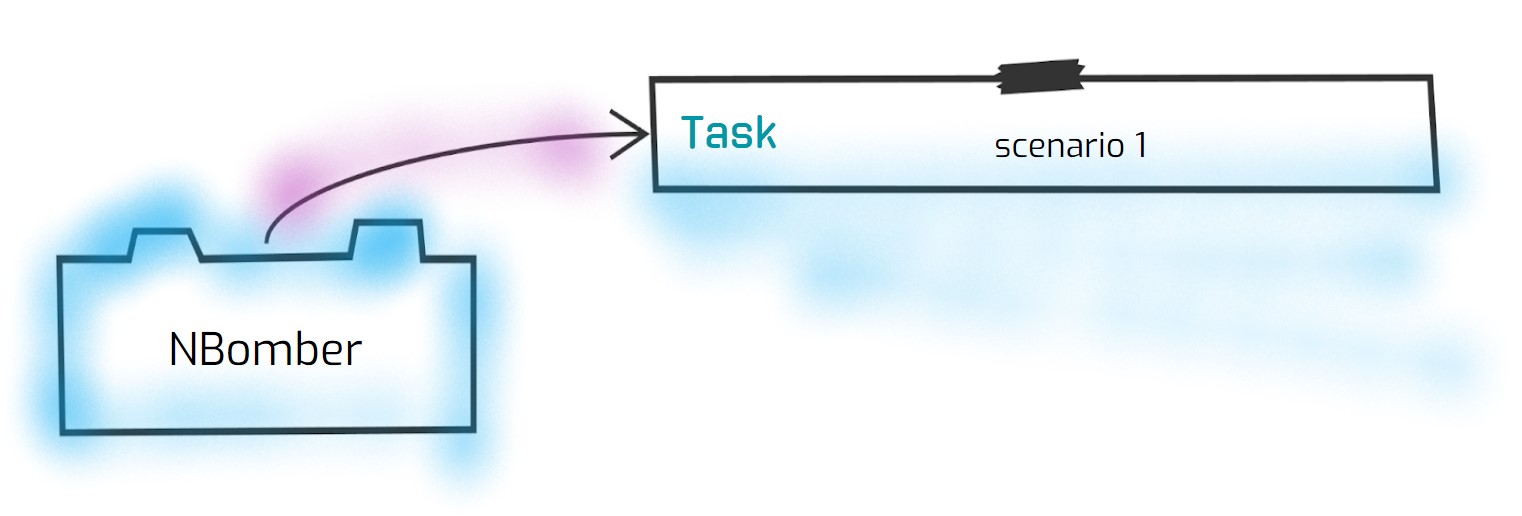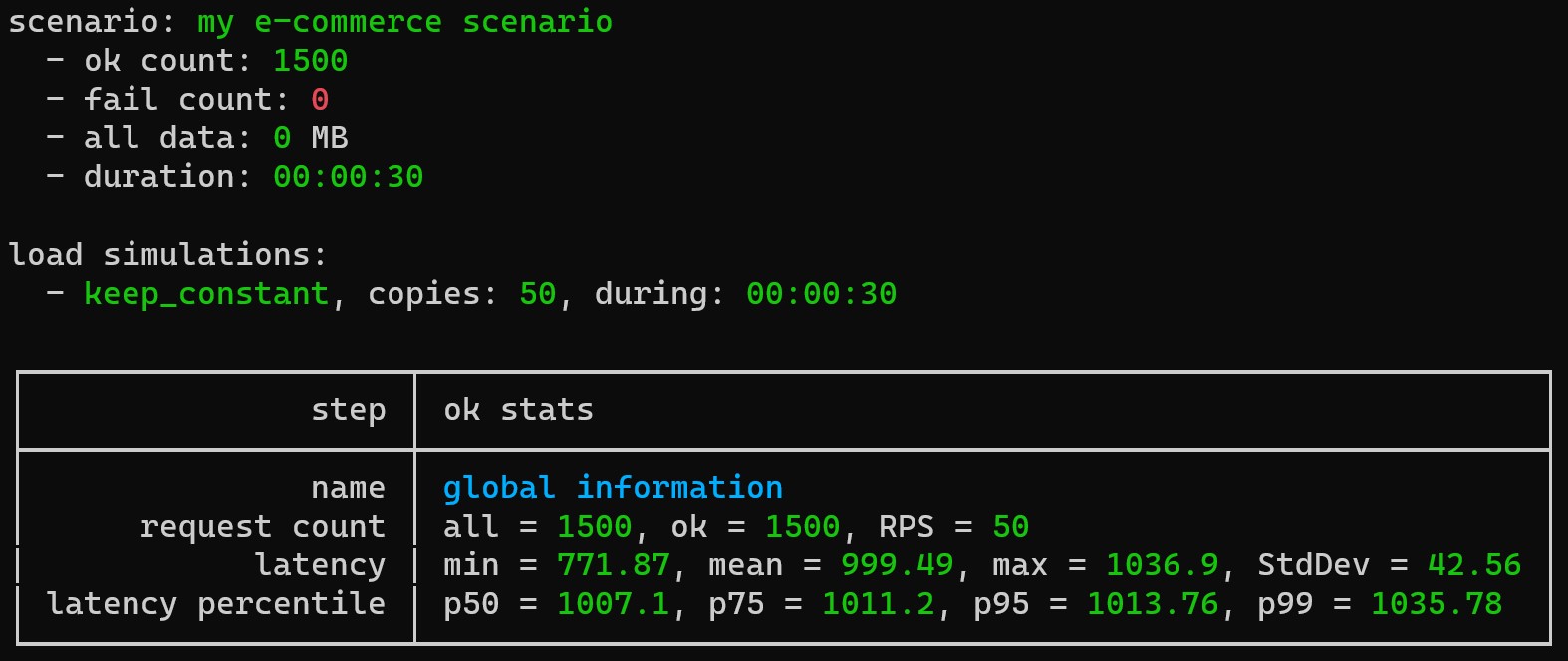Scenario

Scenario play the most crucial role in building load tests with NBomber. Scenario represents typical user behavior. In other words - it’s a workflow that virtual users will follow. Technically speaking, each Scenario instance works as a dedicated .NET Task.
Scenario Create
This method should be used to create Scenario.
public static ScenarioProps Create(string name, Func<IScenarioContext, Task<IResponse>> run)
Imagine that you need to model a simple workflow where the user will do the following:
- Login
- Open home page
- Logout
And this is how it can be modeled using the Scenario.Create method:
var scenario = Scenario.Create("my e-commerce scenario", async context =>
{
await Login();
await OpenHomePage();
await Logout();
return Response.Ok();
});
When you run this scenario, NBomber will measure the whole scenario execution. At the end of execution, NBomber will printout the scenario's statistics result:
Global Information - displays statistics for the whole scenario execution. To get measurements for each action (Login, Logout, etc.) separately, you must wrap the important user action into a Step. The Step helps you granulate your Scenario execution on parts and measure them separately.

Scenario Init
This method should be used to initialize Scenario and all its dependencies. You can use it to prepare your target system, populate the database, or read and apply the JSON configuration for your scenario.
Scenario init will be invoked before warm-up and bombing phases. If Scenario init throws an exception, the NBomber load test will stop the execution.
public ScenarioProps WithInit(Func<IScenarioInitContext, Task> initFunc)
Example:
var scenario = Scenario.Create("scenario_with_init", async context =>
{
await Task.Delay(1_000);
return Response.Ok();
})
.WithInit(context =>
{
// You can do here any initialization logic: populate the database, etc.
context.Logger.Information("MY INIT");
return Task.CompletedTask;
});
You can find the complete example by this link.
One of the widespread use cases for scenario init is to fetch a global JWT token for the whole load test scenario.
var myGlobalJWT = "";
var scenario = Scenario.Create("scenario_with_init", async context =>
{
await Task.Delay(1_000);
return Response.Ok();
})
.WithInit(async context =>
{
using var client = new HttpClient();
myGlobalJWT = await client.GetStringAsync("https://myhost/jwt");
});
Another widespread use case is to get and apply CustomSettings for the Scenario from the JSON configuration file. You can find the complete example by this link.
var scenario = Scenario.Create("scenario_with_init", async context =>
{
await Task.Delay(1_000);
return Response.Ok();
})
.WithInit(context =>
{
var customSettings = context.CustomSettings.Get<CustomScenarioSettings>();
context.Logger.Information(
"test init received CustomSettings.TestField '{TestField}'",
customSettings.TestField
);
});
Scenario Clean
This method should be used to clean the scenario's resources after the test finishes.
Scenario clean will be invoked after warm-up and bombing phases. If Scenario clean throws an exception, the NBomber logs it and continues execution.
public ScenarioProps WithClean(Func<IScenarioInitContext, Task> cleanFunc)
Example:
var scenario = Scenario.Create("scenario_with_clean", async context =>
{
await Task.Delay(1_000);
return Response.Ok();
})
.WithClean(context =>
{
// You can do here any cleaning logic: clearing the database, etc.
context.Logger.Information("MY CLEAN");
return Task.CompletedTask;
});
You can find the complete example by this link.
Scenario Context
ScenarioContext represents the execution context of the currently running Scenario. It provides functionality to log particular events, get information about the test, thread id, scenario copy/instance number, etc. Also, it provides the option to stop all or particular scenarios manually.
interface IScenarioContext
{
TestInfo TestInfo { get; }
ScenarioInfo ScenarioInfo { get; }
NodeInfo NodeInfo { get; }
ILogger Logger { get; }
int InvocationNumber { get; }
Dictionary<string,obj> Data { get; }
void StopScenario(string scenarioName, string reason);
void StopCurrentTest(string reason);
}
Example:
var scenario = Scenario.Create("hello_world_scenario", async context =>
{
// we can log data
context.Logger.Information("the current session id {0}", context.TestInfo.SessionId);
if (context.InvocationNumber > 10)
{
context.Logger.Debug("the current Scenario copy was invoked more than 10 times");
}
if (context.NodeInfo.CurrentOperation == OperationType.Bombing)
{
context.Logger.Debug("Bombing!!!");
}
else if (context.NodeInfo.CurrentOperation == OperationType.WarmUp)
{
context.Logger.Debug("Warm Up!!!");
}
return Response.Ok();
});
Another popular usage of ScenarioContext is related to share data between steps that you can find by this link.
Scenario WarmUp
This method sets duration of warm-up phase. By default warm-up duration is 30 seconds.
public ScenarioProps WithWarmUpDuration(TimeSpan duration)
This method disables warm-up.
public ScenarioProps WithoutWarmUp()
Example 1 (enable warm-up):
var scenario = Scenario.Create("scenario", async context =>
{
await Task.Delay(1_000);
return Response.Ok();
})
.WithWarmUpDuration(TimeSpan.FromMinutes(1));
Example 2 (disable warm-up):
var scenario = Scenario.Create("scenario", async context =>
{
await Task.Delay(1_000);
return Response.Ok();
})
.WithoutWarmUp();
Scenario LoadSimulations
This method allows configuring the load simulations for the current Scenario. Load simulation allows configuring parallelism and workload profiles. To get more info please follow this link.
Default value is: Simulation.KeepConstant(copies: 1, during: TimeSpan.FromMinutes(1))
public ScenarioProps WithLoadSimulations(params LoadSimulation[] loadSimulations)
Example:
var scenario = Scenario.Create("hello_world_scenario", async context =>
{
await Task.Delay(1_000);
return Response.Ok();
})
.WithoutWarmUp()
.WithLoadSimulations(
Simulation.RampingInject(rate: 50, interval: TimeSpan.FromSeconds(1), during: TimeSpan.FromMinutes(1)),
Simulation.Inject(rate: 50, interval: TimeSpan.FromSeconds(1), during: TimeSpan.FromMinutes(1))
);
Scenario RestartIterationOnFail
This method allows enabling or disabling the reset of Scenario iteration in case of Step failure. The default value is true.
public ScenarioProps WithRestartIterationOnFail(bool shouldRestart)
By default, when a Step returns a failed Response or unhandled exception was thrown, NBomber will automatically mark the whole iteration as failed and restart it. The configuration value of RestartIterationOnFail should be set to false to change this behavior and prevent auto restart of Scenario iteration.
Sometimes, you would like to handle failed steps differently: retry, ignore or use a fallback. For such cases, you can disable scenario iteration restart.
Example: In this example, we will execute a Step, and when the response is finished with an error, we should retry it until it succeeds.
var scenario = Scenario.Create("scenario", async context =>
{
var counter = 0;
var step1Response = Response.Fail<string>();
while (step1Response.IsError)
{
step1Response = await Step.Run("step_1", context, async () =>
{
counter += 1;
await Task.Delay(1000);
return counter == 3
? Response.Ok(payload: "ok response")
: Response.Fail<string>();
});
}
return Response.Ok();
})
.WithRestartIterationOnFail(shouldRestart: false); // by default it's true
Scenario MaxFailCount
This method overrides the default value of MaxFailCount for Scenario. By default the MaxFailCount = 5_000. MaxFailCount is incremented on every failure or failed Response. When a scenario reaches MaxFailCount, NBomber will stop the whole load test.
In the case of cluster mode, MaxFailCount is tracked per each NBomber instance exclusively. It doesn't aggregate across the cluster. So if on any NBomber node MaxFailCount is reached, NBomber will stop the whole load test.
public ScenarioProps WithMaxFailCount(int maxFailCount)
Usually, when a scenario gets too many errors, it does make sense to stop it earlier since continuing running produces more problems and often does not make much sense. Especially for this case, NBomber counts all scenario's failures, and if the counter reaches the MaxFailCount, NBomber will stop the test early.
Example:
var scenario = Scenario.Create("scenario", async context =>
{
await Task.Delay(1_000);
return Response.Ok();
})
.WithMaxFailCount(10);
Empty scenario
This method creates empty Scenario.
public ScenarioProps Empty(string name)
An empty Scenario is useful when you want to create the scenario to do only initialization or cleaning and execute it separately. The need for this can be when you have a few scenarios with the same init logic, and you want to run this init logic only once. Instead of using workarounds, you can separate the init logic into the dedicated scenario.
Example:
var initDbScn =
Scenario
.Empty("populate_database_scenario")
.WithInit(async context =>
{
// here we can populate our DB
await Task.Delay(5000);
})
.WithClean(async context =>
{
// here we can do a cleanup for our DB
await Task.Delay(5000);
});